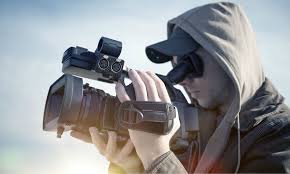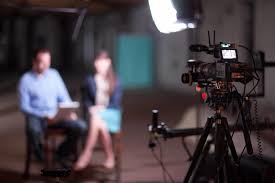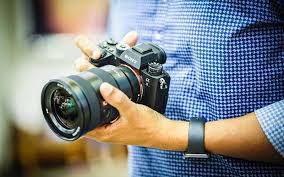Top Tools Every Videographer Needs to Shoot Great Video
Whether you’re putting together a porch swing or building a bookshelf, one of the first things you’ll find printed on the assembly instructions is a list of the tools needed for the job. If your toolbox contains the right tools you’re good to go; without them you won’t get far. The same is true for your camera bag. With a small collection of essential production tools you’ll be equipped to tackle every obstacle on any shoot. Here is a list to the top tools a serious shooter shouldn’t leave home without.
1) Tripod. Shooting steady shots and making smooth camera moves are absolutely essential for professional production, and the best way is to work from a tripod. Remember, all tripods are not created equal. Make sure yours is designed for shooting video, not still photos. This typically means the tripod has a true fluid pan/tilt head, pan handles and adjustable drags.
2) External Microphone(s). While your camcorder’s built-in microphone typically has a decent quality omni-directional pickup element, its fixed position on the front of your camera keeps you from getting great sound unless you press your lens right up against your subject. The best way to record clean, clear audio is to get your mic close to the subject. This means getting it off your camera. Microphones come in many shapes and sizes to do a variety of jobs. The most commonly used and versatile are handheld “stick” mics and clip-on lavalieres. If you are shooting with a DSLR, you should carry an external audio recorder like the Tascam DR-07mkII, or the Zoom H4N.
3) Headphones. Invest in a pair of good quality over-the-ear headphones that block outside noise and let you clearly hear what your mic is recording. What’s the biggest trick to getting great results from headphones? You have to plug them in and put them on. They may look cool hanging around your neck, but they aren’t effective unless they are actually on your ears. Because you will be wearing them for the duration of your shoot, choose a pair that not only sounds good, but fits comfortably.
4) Reflector/Bounce Card. Reflectors and bounce cards will help you light right while you run and gun. A properly positioned reflector lets you create a polished lighting look from a single source, whether it’s the sun, an incandescent bulb, or a Fresnel. Professional photo/video reflectors are often flexible, circular and shiny, with silver or gold surfaces. They tend to bounce hard, intense light, and are susceptible to “wiggle” when used in the wind. White foam core cards are a popular alternative that many pros prefer. In addition to being inexpensive and easily accessible, they are rigid, and cast a soft, diffused light that is appealing on talent. You can also use them for setting white balance and for blocking your mics from buffering breezes.
5) Gaffer’s Tape. A big ol’ roll of good gaff tape is one of the most useful tools for the resourceful shooter. Gaffer’s tape is not the same as duct tape, electrical tape or masking tape. It is a specially formulated cloth tape with glue that holds firm without making a mess. Although gaffer’s tape can be a little pricey, this is not the place to cut corners on cost. Use it for taping down power cords, taping on microphones or taping up a loose tripod leg. If MacGyver made video, gaff tape would be his favorite tool.
6) Backup Batteries. As advanced as our cameras have become, they still rely on battery power. If those pint-sized power packs decide to die and you are unprepared, you’re done. So, always bring a backup battery, and your charger. While one battery is powering your camera, keep another on the charger and plugged in. It’s also a good idea to carry a collection of 9-volts and AAs to use with your mics so you are never without.
7) Your Camera. Don’t forget to pack your camera itself! Batteries, microphones, tape and reflectors aren’t much good on their own. When you pack your camera, be sure to put on your lens cap, and make sure the camera is held snugly in place so it doesn’t jostle around. Even hefty-feeling cameras are vulnerable to damage if they bounce around loosely in the bag.

The 7 Best DSLRs/Mirrorless Cameras for Video
A good DSLR can take high-quality video, operate well in low light situations, accept external microphones, and, of course, also take high-quality still photographs. While most modern DSLRs have video capabilities, some rise above the rest when it comes to specific features that videographers want.
It wasn’t long ago that people used only little camcorders for making videos but now we have a lot of options. Many are turning to DSLRs to get the job done. A good DSLR can take high-quality video, operate well in low light situations, accept external microphones, and, of course, also take high-quality still photographs.
While most modern DSLRs have video capabilities, some rise above the rest when it comes to specific features that videographers want. Here we’ll talk about some of the things to look for when choosing a DSLR or mirrorless camera for video and give recommendations for some of our favorites and picks for the best mirrorless camera for video.
The Best DSLR for Video
- Canon 5D Mark III
- Sony Alpha a7SII
- Nikon D810
- Panasonic Lumix GH4
- Canon 80D
- Canon T6i
- Nikon D3300

Operators and editors.
In the pro broadcast world, there two types of editors: Operators and editors.
An operator is someone who should be an expert at the software, understands codecs, as well as the export parameters needed for broadcast. Very often, these people are not particularly creative, because creativity is not their main focus. Often, it’s the technical side of video that excites them the most.
Before you do this course, I have a question:
- Do you mainly want to be taught all the technical stuff regarding video production? (called an operator-editor) Or. .
- Do you want to become a creatively intuitive, clever video editor, that can create amazing content from your, or other people’s footage? (called an editor) If yes, then this course is for you.
If you answered 1, then this is not a course for you. I don’t teach the tech stuff at all. Because, honestly, I am no expert myself. I have worked in broadcast TV as an editor for 37 years, won awards in New York and Cannes, and yet I still only have a basic understanding of the tech stuff. Because, believe it or not, I don’t need it. And neither do you!
I am an editor. I am not an operator.
Editing video (understanding the software) is a straightforward, if complex subject. It is taught all over the Internet. But find me a truly creative video editing course. I can’t find a good one anywhere. So I created this one.
Editing video is easy to do, but difficult to do well.
The trouble is, most video courses on the net are presented by filmmakers making wedding videos and low budget music videos. Very few are broadcast professionals. The proof is that most video editing courses focus primarily on software, which requires limited creative insight.

WHAT DOES A FILM EDITOR DO?
At the most basic level, a film editor’s job is telling a story. Combining various clips and audio together to create a cohesive vision is the goal. Much like engineers, film and video editors wear take up multiple roles. They often look over a wide-range of projects to make sure there are no errors or inconsistencies.
A film editor’s job can include everything from working with the director to helping rewrite scripts and editing storyboards. An important part to a film editor’s job is communication. There is a lot of back and forth when it comes to their work and their clients. Even though it gets tedious to approve new changes, alter existing video and rewrite certain parts, it’s all part of the process, and these experiences help you land more film editor jobs in the future.
The WORST questions to ask your wedding videographer
1. How many other weddings is the videographer shooting on your wedding day or weekend?
Unless your videographer has a time machine, it’s impossible to film more than one wedding in a single day.
2. Do you offer Non-Linear Digital Editing. Request an explanation of the technological process.
Unless you work in the film industry, don’t waste time learning about the benefits of Apple ProRes 422 HQ codecs and other unnecessary details. Focus on important things like their style and quality.
3. What types of cameras, tapes and microphones do they use?
It’s important to know that the gear is both modern and professional quality, but unless you know a lot about cameras and microphones you probably don’t wouldn’t care if they are using a Sennheiser MKE-400 Shotgun vs a Rode VideoMicPro Shotgun microphone on their camera.
4. Do you shoot in color and black & white?
If you see this question in a bridal magazine it’s written by someone that was around when black and white film was common. Either the article and magazine is covered in dust or they don’t understand modern technology.
5. Do you deliver on VHS?
VHS tapes are ancient history, if you visit a videographers website that mentions VHS you should leave now!